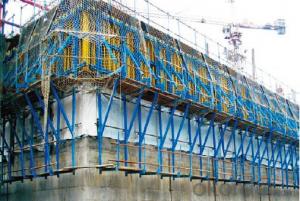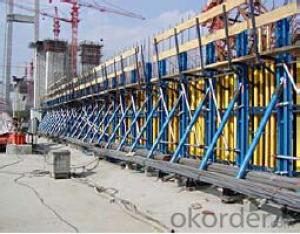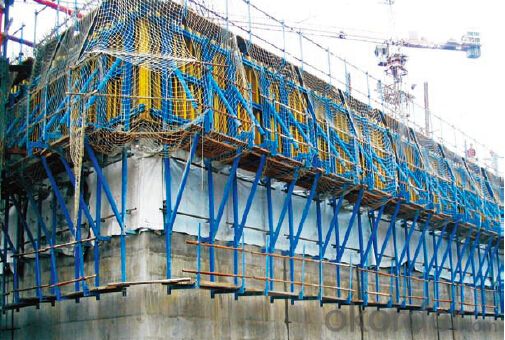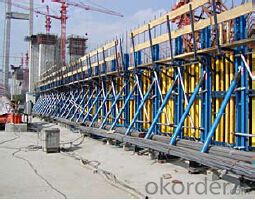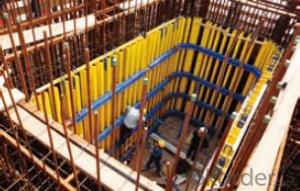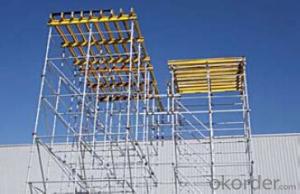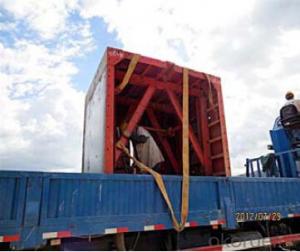Single Side Climbing Bracket for Formwork and Scaffolding System
- Loading Port:
- Tianjin
- Payment Terms:
- TT OR LC
- Min Order Qty:
- 50 m²
- Supply Capability:
- 1000 m²/month
OKorder Service Pledge
OKorder Financial Service
You Might Also Like
Single-side Climbing Bracket SCB180:
With CNBM SCB 180 climbing systems, the loads from the fresh concrete pressure are
transferred through the brackets by means of V-strongbacks and compression braces into the
scaffold anchors.
Typical applications for the SCB 180 are dams, locks, cooling towers, pier heads, tunnels, and
bank vaults.
The formwork is simply tilted backwards when striking takes place. The 1.80 m wide bracket
requires only a minimum of space.
Characteristics:
◆ Economical and safe anchoring
The M30/D20 climbing cones have been designed especially for single-sided concreting using
SCB180 in dam construction, and to allow the transfer of high tensile and shear forces into the still
fresh, unreinforced concrete. Without wall-through tie-rods, finished concrete is perfect.
◆ Stable and cost-effective for high loads
generous bracket spacings allow large-area formwork units with optimal utilization of the bearing
capacity. This leads to extremely economical solutions.
◆ Simple and flexible planning
With SCB180 single-sided climbing formwork, circular structures can also be concreted without
undergoing any large planning process. Even use on inclined walls is feasible without any special
measures because additional concrete loads or lifting forces can be safely transferred into the
structure.
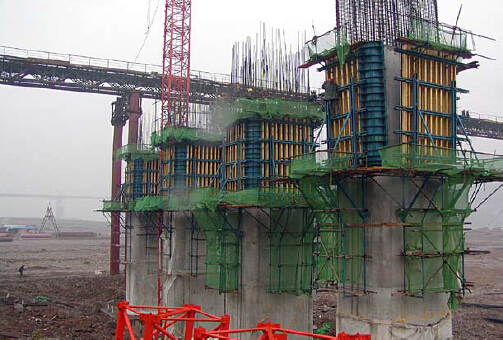
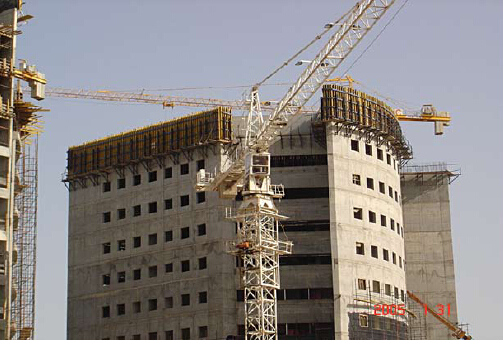
- Q: Can steel formwork be used for precast concrete wall panels?
- Yes, steel formwork can be used for precast concrete wall panels. Steel formwork is commonly used in the construction industry as it provides excellent strength, durability, and stability. It allows for precise shaping and ensures a smooth finish on the concrete wall panels. Additionally, steel formwork can be reused multiple times, making it cost-effective for precast concrete production.
- Q: Are there different sizes of steel formwork available?
- Yes, there are different sizes of steel formwork available.
- Q: Can steel formwork be used for curved or non-standard concrete shapes?
- Yes, steel formwork can be used for curved or non-standard concrete shapes. Steel is a very versatile material that can be easily manipulated into various shapes, making it ideal for forming concrete structures with unique and intricate designs. Unlike traditional wooden formwork, steel formwork can be bent, twisted, and shaped to accommodate any desired curvature or non-standard shape. Additionally, steel formwork offers excellent strength and durability, ensuring that it can withstand the pressure exerted by the concrete during pouring and curing. Therefore, steel formwork is commonly used in construction projects that require curved or non-standard concrete shapes, such as architectural features, decorative elements, or complex structural components.
- Q: What are the different types of coatings available for steel formwork?
- There are several types of coatings available for steel formwork, each with its own unique advantages and applications. 1. Paint coatings: These coatings provide a basic level of protection against corrosion and can be applied in various colors. They are typically inexpensive and easy to apply, making them a popular choice for general-purpose formwork. 2. Galvanized coatings: Galvanizing involves applying a layer of zinc to the steel surface, providing excellent corrosion resistance. It is particularly suitable for formwork used in harsh environments or where long-term durability is required. 3. Epoxy coatings: Epoxy coatings offer superior chemical resistance and durability compared to other types of coatings. They are commonly used in formwork that will come into contact with aggressive substances or in applications requiring a high level of hygiene, such as in the food industry. 4. Powder coatings: Powder coatings are applied as a dry powder and then baked to form a hard, durable finish. They offer excellent impact resistance and are available in a wide range of colors. Powder coatings are often used in formwork that will be exposed to significant wear and tear. 5. Polymer coatings: Polymer coatings, such as polyurethane or polyethylene, provide a protective layer over the steel surface. They offer good resistance to abrasion, impact, and chemicals, making them suitable for formwork used in demanding applications. 6. Thermal spray coatings: Thermal spray coatings involve the application of a molten material, such as zinc or aluminum, onto the steel surface. These coatings offer exceptional corrosion resistance and are commonly used in marine or offshore formwork. When selecting the appropriate coating for steel formwork, factors such as the intended use, environmental conditions, and budget should be considered. It is important to consult with coating specialists or manufacturers to determine the most suitable coating for specific applications.
- Q: Can steel formwork be easily dismantled and removed after construction?
- Steel formwork is designed to be easily dismantled and removed after construction, providing a cost-effective and sustainable option for construction projects. It can withstand the weight and pressure of the concrete during the construction process. Once the construction is complete and the concrete has cured, the steel formwork can be dismantled using basic tools like hammers and wrenches. The individual components of the formwork can be unbolted and removed from the concrete structure. After dismantling, the steel formwork can be cleaned, inspected, and stored for future use, reducing the need for new formwork in future construction projects. In conclusion, the use of steel formwork offers the advantage of easy dismantling and removal, contributing to its cost-effectiveness and sustainability in construction projects.
- Q: Are there any specific considerations for using steel formwork in areas with high humidity?
- Yes, there are specific considerations for using steel formwork in areas with high humidity. Steel formwork is prone to corrosion when exposed to high levels of moisture in the air. Therefore, it is essential to protect the steel formwork with appropriate coatings or sealants to prevent rust and degradation. Regular inspections and maintenance should also be carried out to ensure the formwork remains in good condition and to address any signs of corrosion promptly. Additionally, selecting the right type of steel and ensuring proper ventilation and drying of the formwork can help mitigate the effects of high humidity on its performance and longevity.
- Q: What is the process for installing steel formwork?
- Installing steel formwork involves several steps that must be followed meticulously to achieve a successful and sturdy structure. To begin, the site must be prepared by clearing away any debris or obstacles that could hinder the installation process. It is essential to ensure that the ground is level and stable, providing a strong foundation for the formwork. Next, the steel formwork panels are positioned and firmly secured to create the desired shape and structure. This is typically achieved by connecting the panels using various types of connectors like bolts or clamps. Once the panels are securely connected, it is crucial to align and level the formwork accurately. This guarantees the stability and accuracy of the structure being formed. Specialized leveling devices, such as laser levels or spirit levels, can be utilized to ensure precise alignment and a square formwork. After achieving alignment, reinforcement bars (rebars) are placed within the formwork to enhance strength and support for the poured concrete. These rebars are positioned according to the structural drawings and are securely tied together using wire or metal ties. Once the reinforcement is complete, the concrete is poured into the formwork. Great care must be taken to ensure even pouring without any voids or air pockets. Concrete vibrators can be used to eliminate trapped air and ensure proper compaction. Once the concrete is poured, it needs to be appropriately cured to attain the desired strength and durability. This can be accomplished by covering the formwork with a curing compound or by implementing water curing methods, such as spraying water or covering it with wet burlap. Finally, after the concrete has cured, the formwork can be dismantled. This process involves carefully removing the formwork panels, connectors, and supports. The formwork panels can then be cleaned and stored for future use or transported off-site. Overall, the installation of steel formwork necessitates meticulous planning, precise alignment, and flawless execution to achieve a successful and structurally sound end result.
- Q: How does steel formwork impact the overall project execution?
- Steel formwork can have a significant impact on the overall project execution. Its strength and durability make it an ideal choice for construction projects, allowing for faster and more efficient work. Steel formwork also provides accurate and precise results, ensuring that the structures are built according to the desired specifications. Additionally, steel formwork is reusable, reducing the overall project costs and minimizing environmental impact. Overall, steel formwork enhances the efficiency, quality, and cost-effectiveness of the project execution.
- Q: Can steel formwork be used for underground structures?
- Yes, steel formwork can be used for underground structures. Steel is a durable and strong material that can withstand the pressure and weight of the soil and other forces that act on underground structures. It provides stability and support during the construction process and helps create a solid and robust structure.
- Q: Can steel formwork be used for complex geometric designs?
- Complex geometric designs can indeed be achieved using steel formwork. Steel, being a versatile material, can be effortlessly shaped and molded into diverse intricate forms, thereby making it well-suited for such designs. By employing steel formwork, construction can be carried out with utmost precision and accuracy, guaranteeing the attainment of the desired shape and dimensions. Moreover, the robustness and longevity of steel render it capable of withstanding the weight and pressure exerted during the pouring of concrete, thus establishing steel formwork as a dependable option for the creation of complex geometric designs in construction endeavors.
Send your message to us
Single Side Climbing Bracket for Formwork and Scaffolding System
- Loading Port:
- Tianjin
- Payment Terms:
- TT OR LC
- Min Order Qty:
- 50 m²
- Supply Capability:
- 1000 m²/month
OKorder Service Pledge
OKorder Financial Service
Similar products
Hot products
Hot Searches
